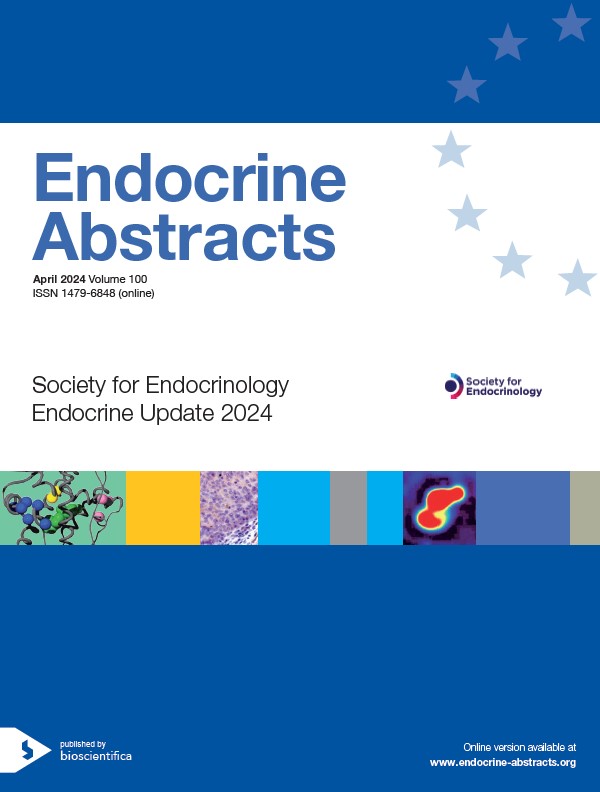
Society for Endocrinology Endocrine Update 2024
Society for Endocrinology Clinical Update 2024
Workshop D: Disorders of the adrenal gland
ea00100wd1.1 | Workshop D: Disorders of the adrenal gland | SFEEU2024
A case of primary hyperaldosteronism: a timeline
Tulsi Dooshyant , Fidelis Adebo Itopa , Ogunko Arthur , Mohandas Cynthia
ea00100wd1.2 | Workshop D: Disorders of the adrenal gland | SFEEU2024
Adrenal mass with neurological presentation
ea00100wd1.3 | Workshop D: Disorders of the adrenal gland | SFEEU2024
A case of ACTH independent Cushing’s syndrome with bilateral adrenal nodules
ea00100wd1.4 | Workshop D: Disorders of the adrenal gland | SFEEU2024
Phaeochromocytoma: a case of recurrent disease
ea00100wd2.1 | Workshop D: Disorders of the adrenal gland | SFEEU2024
Reninoma: a rare cause of hypertension in pregnancy
Green Deirdre , Plant Liam , O'Halloran Domhnall
ea00100wd2.2 | Workshop D: Disorders of the adrenal gland | SFEEU2024
A patient with two forms of PA - pituitary adenoma and primary aldosteronism
ea00100wd2.3 | Workshop D: Disorders of the adrenal gland | SFEEU2024
A case of synchronous phaeochromocytoma and renal cell carcinoma
ea00100wd2.4 | Workshop D: Disorders of the adrenal gland | SFEEU2024
Advanced and aggressive metastatic adrenocortical carinoma in a 30-year old gentleman
Hoskins Felicity , Ahmed Ahmed
ea00100wd3.1 | Workshop D: Disorders of the adrenal gland | SFEEU2024
Primary aldosteronism in a young man with a family history of hypertension and stroke
ea00100wd3.2 | Workshop D: Disorders of the adrenal gland | SFEEU2024
Primary hyperaldosteronism in a patient with cushing’s disease in remission
Tomkins Maria , Carthy Claire , Finnegan John , Mulholland Douglas , Dugal Neal , W O'Reilly Michael , Sherlock Mark
ea00100wd3.3 | Workshop D: Disorders of the adrenal gland | SFEEU2024
Bilateral phaeochromocytoma heralding a diagnosis of MEN 2A
Faheem Muhammad , Casey Ruth , Stokes Victoria , Schoenmakres Nadia
ea00100wd3.4 | Workshop D: Disorders of the adrenal gland | SFEEU2024
Unravelling silent phaeochromocytoma in MEN-2A
ea00100wd4.1 | Workshop D: Disorders of the adrenal gland | SFEEU2024
Follow up for primary hyperaldosteronism – how long is long enough?
Alington Katherine , Bujanova Jana
ea00100wd4.2 | Workshop D: Disorders of the adrenal gland | SFEEU2024
Hirsutism and incidental pheochromocytoma
ea00100wd4.3 | Workshop D: Disorders of the adrenal gland | SFEEU2024
A case of phaeochromocytoma-optimisation of alpha and beta blockage
Thinn Yu Thinn , Akker Scott , Parvanta Laila
ea00100wd4.4 | Workshop D: Disorders of the adrenal gland | SFEEU2024
Pheochromocytoma presenting as acute coronary syndrome
Malik Sakshi , Haroon Riasat Muhammad , Bakht Khush
ea00100wd5.1 | Workshop D: Disorders of the adrenal gland | SFEEU2024
Delayed presentation of adrenal insufficiency during covid pandemic
ea00100wd5.2 | Workshop D: Disorders of the adrenal gland | SFEEU2024
A case of primary aldosteronism with hypertrophic cardiomyopathy and a horseshoe kidney
Conti Alessandro , Goodchild Emily , Drake William
ea00100wd5.3 | Workshop D: Disorders of the adrenal gland | SFEEU2024
A case of pheochromocytoma crisis presented as acute multi-organ failure and cardiac arrest
Akram Yousif Zainab , Ayuk John
ea00100wd5.4 | Workshop D: Disorders of the adrenal gland | SFEEU2024
A case of VHL presenting with phaeochromocytoma
Poe Poe Han Htwe Nang , Abbas Afroze



